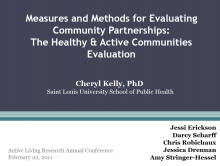We are pleased to announce an exciting new alliance between Active Living Research and GP RED to co-host and coordinate...
Measures and Methods for Evaluating Community Partnerships: The Healthy & Active Communities Evaluation

Presentation at the 2011 Active Living Research Annual Conference
Background: The Missouri Foundation for Health (MFH) established the Healthy & Active Communities (H&AC) initiative in 2005 to respond to increased obesity rates throughout the state. Funded projects are using various methods for combating obesity, including changes to the built environment, advocacy and policy change activities, and direct programming to influence individual behavior. The H&AC initiative recognizes the importance of both traditional and non-traditional partners in contributing to successful program implementation and sustainability of efforts. Multi-sectoral partnerships contribute a variety of valuable resources and expertise that strengthen community-based efforts. Evaluating partnership networks and how partners contribute to policy and environmental changes is critical for establishing best practices for obesity prevention programs.
Objectives: To evaluate the extent to which community partnerships contribute to policy and environmental changes.
To use a mixed methods approach to evaluate the role of community partnerships in obesity prevention efforts.
Methods: Assessing community partnerships was identified as a key piece of the H&AC evaluation. Evaluation questions related to partnerships include: Who are the key partners to the program and what qualities of the partnerships make them successful? What did partners contribute to the implementation of policy, built environment change, and community engagement activities?; How did partnership networks contribute to sustainability of program efforts? To answer these questions, a mixed methods approach was implemented.
The use of quantitative and qualitative methods helps to provide a comprehensive picture of the role of partnerships in achieving policy and environmental changes. A web-based monitoring system was developed to collect partnership data from the 35 projects on a monthly basis. The partnership measures include descriptive characteristics of each partner (e.g., type of partner organization, service area of partner, role of partner in program). This allows the evaluation to obtain a clear picture of partnership distribution within the initiative and identify trends associated with community-based partnership networks. Additionally, the system collects data about the types of partnership development activities conducted by the projects (e.g., provided resources to partner, conducted action planning with partners, worked with partners on advocacy or policy issues). Data about partnership development activities is used to identify how partners contribute to successful project activities and outcomes.
Qualitative key informant interviews are also conducted with several key personnel from each project site on an annual basis. Interview topics addressing partnerships include: identification of key partnerships for the project, description of each partners’ contributions, challenges with partnerships, and identification of partners missing from the network. A thematic analysis is conducted across the projects. The triangulation of the qualitative and quantitative data provides the evaluation with a comprehensive method for evaluating partnerships.
Results: Initial descriptive data analyses show that the H&AC projects (n=35) have an extensive partnership network (n=427). The primary type of partner organization identified was community or neighborhood organization (26%), followed by schools, childcare, and non-school hour programs (22%) and local businesses (17%). Additionally, faith-based organizations (8%), local governments (7%), and healthcare providers (6%) were represented in the partnership network. Partners played various roles within the H&AC projects (e.g., providing funding and resources, promoting program activities and objectives, providing expertise and training). In-depth qualitative and quantitative analyses will be conducted to examine the extent of the partner contributions, role of partners in sustaining the projects, and how partnerships affected policy and environmental change efforts.
Conclusions: The design of the H&AC evaluation provides a valuable resource for programs looking to evaluate partnership networks. The methods and measures developed are effective at assessing the diversity of partnerships and how partners contribute to community-based programs focused on policy and environmental changes. Other researchers and evaluators can replicate the mixed method process to evaluate partnerships within other initiatives and multi-site obesity prevention projects.
STAY UP TO DATE
RECENTLY ADDED TOOLS & RESOURCES
MOVE! A BLOG ABOUT ACTIVE LIVING
The "Active Living Conference" aims to break down research and practice silos and...







